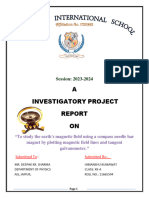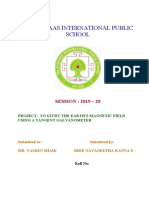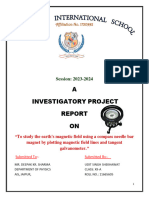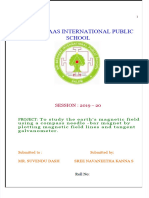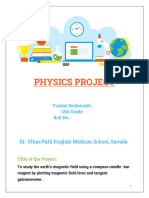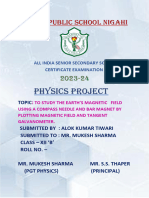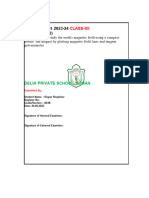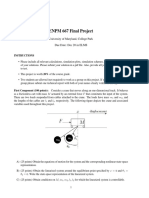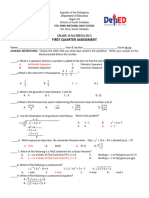INVESTIGATORY PROJECT
Title
“To Study the Earth's Magnetic Field Using a Compass
Needle- Bar Magnet by Plotting Magnetic Field Lines and
Tangent Galvanometer”
Project Submitted By:
Mast. Pushkar Vijay Kambe
Class: 12th
Under the Guidance of
Ms. Shilpa Rewatkar
Subject Teacher
ST. Paul School CBSE
Hudkeshwar Road, Near Bridge, Nagpur – 4400347
1
� Acknowledgment
I would like to express my heartfelt gratitude to my teacher, Prof. Shilpa Rewatkar for her
guidance and support in completing this investigatory project. I also extend my thanks to
my school, St Paul School, for providing laboratory facilities. I am grateful to my parents
for their encouragement and constant support. Lastly, I thank my peers and friends who
helped me during this project.
Pushkar Vijay Kambe
2
� Certificate
This is to certify that Pushkar Vijay Kambe, a student of Class 12 th, has successfully
completed the investigatory project titled “To Study the Earth's Magnetic Field Using
a Compass Needle- Bar Magnet by Plotting Magnetic Field Lines and Tangent
Galvanometer” ” under the guidance of Ms. Shilpa Rewatkar. To the best of my
knowledge, it is an original piece of work and is worthy of consideration in partial
fulfilment of the requirement of CBSE.
Prof. Shilpa Rewatkar Mr. Dewagana Punde
Subject Teacher Principal
3
� Index Page
1. Introduction
2. Objectives
3. Theory and Principles
4. Materials and Apparatus
5. Experimental Setup and Procedure
6. Observations
7. Data Analysis
8. Results and Discussion
9. Applications
10. Conclusion
11. Bibliography
4
�1. Introduction
The tangent galvanometer was first described in an 1837 by Claude-Servais- Mathias
Pouillet, who later employed this sensitive form of galvanometer to verify Ohm’s law. To
use the galvanometer, it is first set up on a level surface and the coil aligned with the
magnetic north-south direction. This means that the compass needle at the middle of the
coil is parallel with the plane of the coil when it carries no current. The current to be
measured is now sent through the coil, and produces a magnetic field, perpendicular to
the plane of the coil and is directly proportional to the current.
The magnitude of the magnetic field produced by the coil is B; the magnitude of the
horizontal component the Earth’s magnetic field is B’. The compass needle aligns itself
along the vector sum of B and B’ after rotating through an angle Ø from its original
orientation. The vector diagram shows that tan
Ø= B/B’. Since the magnetic field of the Earth is constant, and B depends directly on the
current, the current is thus proportional to the tangent of the angle through which the
needle has turned.
Earth’s magnetic field is also referred to as the geomagnetic field. The earth’s magnetic
field extends millions of kilometers into outer space and looks very much like a bar
magnet. The earth’s south magnetic pole is actually near the North Pole and the
magnetic north pole is in Antarctica! This is why a compass magnet’s North Pole
actually points north (north and south poles attract). The Earth’s magnetic field extends
far and wide but is very weak in terms of field strength. A mere 40,000 nT compared to
a refrigerator magnet which has a strength of 10.
The Earth’s magnetic field extends far and wide but is very weak in terms of field
strength. A mere 40,000 nT compared to a refrigerator magnet which has a strength of
107 nT!.
This project investigates the Earth's magnetic field using simple tools like a compass, bar
magnet, and tangent galvanometer. The study aims to demonstrate the magnetic field
5
�lines and analyze the Earth's natural magnetism. This foundational concept has practical
applications in navigation, geophysics, and modern engineering.
Importance of the Earth's Magnetic Field
The Earth's magnetic field has been crucial in human history and scientific exploration.
For centuries, humans have relied on compasses, which align with the magnetic field, to
navigate the globe. Modern applications include:
Navigation Systems: Magnetic sensors in smartphones and GPS systems.
Space Exploration: Protecting astronauts and satellites from solar wind.
Geophysical Research: Studying the Earth's structure and detecting minerals.
Magnetic Poles and Their Shifts
The Earth has two magnetic poles: the north and south magnetic poles. Unlike the
geographic poles, these are not fixed and shift over time due to changes in the Earth's
core dynamics. This phenomenon is called geomagnetic secular variation.
Magnetic Reversals: Over geological time, the Earth's magnetic field has
reversed, switching the north and south poles. The last reversal occurred about
780,000 years ago.
Current Pole Movement: The magnetic north pole is currently moving towards
Siberia at a rate of approximately 10 kilometers per year.
2. The objectives of this study are:
To plot the magnetic field lines of a bar magnet using a compass needle.
To verify the tangent law of magnetism using a tangent galvanometer.
To determine the horizontal component of the Earth's magnetic field using the
galvanometer.
To analyze the relationship between current and magnetic deflection.
To enhance understanding of magnetic field phenomena.
6
�3. Theory and Principles
3.1 Earth's Magnetic Field
The Earth's magnetic field behaves like that of a giant bar magnet tilted at an angle of
approximately 11 degrees from its rotational axis. It has a north and south magnetic pole.
Magnetic field lines emerge from the magnetic north pole and enter the magnetic South
Pole, creating a closed loop.
3.2 Magnetic Field Lines
Magnetic field lines visually represent the magnetic field's direction and strength. The
denser the lines, the stronger the magnetic field.
3.3 Tangent Law of Magnetism
The tangent law states that when a magnetic needle is placed in two perpendicular
magnetic fields (one horizontal component of the Earth’s magnetic field and another due
to current in a coil), the needle aligns itself at an angle such that:
Where:
B = Magnetic field produced by the tangent galvanometer.
BH = Horizontal component of Earth's magnetic field.
The Physics of Magnetic Fields
The magnetic field around a current-carrying conductor was first observed by Hans
Christian Ørsted in 1820. He showed that electric currents produce a magnetic field,
linking electricity and magnetism. This phenomenon laid the foundation for the
development of the tangent galvanometer.
Tangent Law:
7
�The tangent law is used to measure the Earth's magnetic field by balancing two
perpendicular fields:
1. The Earth's horizontal magnetic field.
2. The field generated by a circular coil in the galvanometer.
3. The needle aligns itself according to the resultant field, and the tangent law allows
precise calculation.
3.4 Tangent Galvanometer
It consists of a circular coil through which current flows. The coil is mounted
vertically such that its plane lies along the magnetic meridian. The current produces
a magnetic field that deflects a compass needle at the centre.
4. Materials and Apparatus
Bar magnet
Compass needle
Tangent galvanometer
DC power source (battery)
Ammeter
Rheostat
Connecting wires
Protractor
Sheet of paper and pencil
5. Experimental Setup and Procedure
5.1 Plotting Magnetic Field Lines of a Bar Magnet
1. Place the bar magnet on a sheet of paper. Fix its position.
2. Mark its north and south poles.
3. Place a compass needle near the magnet’s North Pole.
4. Mark the position of the needle's north end. Move the compass along the field line
and repeat.
8
� 5. Repeat for different positions around the magnet to create a pattern of field lines.
5.2 Using the Tangent Galvanometer
1. Set up the tangent galvanometer with its coil in the plane of the magnetic meridian.
2. Connect the battery, rheostat, and ammeter in series with the galvanometer.
3. Pass a small current through the circuit and adjust it using the rheostat.
4. Record the angle of deflection (θ) of the compass needle.
5. Measure the current using the ammeter.
6. Repeat for different currents and note the observations.
6. Observations
Current (III) in Amperes Deflection Angle (θ) Tangent of Angle (tanθ)
0.2 15° 0.267
0.4 30° 0.577
0.6 45° 1.000
7. Data Analysis
9
� Use the formula tanθ=B/BH to calculate BH, the horizontal component of the
Earth's magnetic field.
When a bar magnet is suspended in two Magnetic fields B and B H, it comes to rest
making an angle θ with the direction of BH.
Plot a graph between current (I) and tanθ to analyse the relationship.
8. Results and Discussion
The experiment demonstrates the Earth's magnetic field's presence and the tangent law of
magnetism. The plotted magnetic field lines verify the concept of magnetic field direction
around a bar magnet. Using the tangent galvanometer, the horizontal component of the
Earth's magnetic field was successfully calculated.
10
�9. Applications
Navigation: Compasses rely on the Earth’s magnetic field for orientation.
Geophysics: Study of geomagnetic variations aids in mineral exploration.
Space Exploration: Protects satellites from solar radiation.
Engineering: Used in magnetic sensors and instruments.
10. Conclusion
The investigatory project successfully validated the principles of magnetism. Magnetic
field lines were plotted, and the tangent law of magnetism was experimentally verified.
The Earth's horizontal magnetic field component was determined using the tangent
galvanometer.
11
�11. Bibliography
NCERT Physics Textbook, Class 12
Resnick, Halliday, and Walker, Fundamentals of Physics
Tangent Galvanometer (Procedure) : Electricity & Magnetism Virtual Lab :
Physical Sciences : Amrita Vishwa Vidyapeetham Virtual Lab
Galvanometer - Wikipedia, the free encyclopaedia
en.wikipedia.org/wiki/Galvanometer
12





